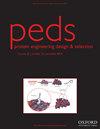Improvement of Moloney murine leukemia virus reverse transcriptase thermostability by introducing a disulfide bridge in the ribonuclease H region.
IF 3.4
4区 生物学
Q3 BIOCHEMISTRY & MOLECULAR BIOLOGY
引用次数: 2
Abstract
Moloney murine leukemia virus (MMLV) reverse transcriptase (RT) is widely used in research and clinical diagnosis. Improvement of MMLV RT thermostability has been an important topic of research for increasing the efficiency of cDNA synthesis. In this study, we attempted to increase MMLV RT thermostability by introducing a disulfide bridge in its RNase H region using site-directed mutagenesis. Five variants were designed, focusing on the distance between the two residues to be mutated into cysteine. The variants were expressed in Escherichia coli and purified. A551C/T662C was determined to be the most thermostable variant.
在核糖核酸酶H区引入二硫桥改善Moloney小鼠白血病病毒逆转录酶的热稳定性。
Moloney小鼠白血病病毒(MMLV)逆转录酶(RT)广泛应用于研究和临床诊断。提高MMLV RT的热稳定性已成为提高cDNA合成效率的重要研究课题。在这项研究中,我们试图通过在其RNase H区引入二硫桥,使用定点诱变来提高MMLV RT的热稳定性。设计了五个变体,重点是两个残基之间的距离,以突变成半胱氨酸。这些变异体在大肠杆菌中表达并纯化。A551C/T662C被确定为最耐热的改型。
本文章由计算机程序翻译,如有差异,请以英文原文为准。
求助全文
约1分钟内获得全文
求助全文
来源期刊

Protein Engineering Design & Selection
生物-生化与分子生物学
CiteScore
3.30
自引率
4.20%
发文量
14
审稿时长
6-12 weeks
期刊介绍:
Protein Engineering, Design and Selection (PEDS) publishes high-quality research papers and review articles relevant to the engineering, design and selection of proteins for use in biotechnology and therapy, and for understanding the fundamental link between protein sequence, structure, dynamics, function, and evolution.
 求助内容:
求助内容: 应助结果提醒方式:
应助结果提醒方式:


